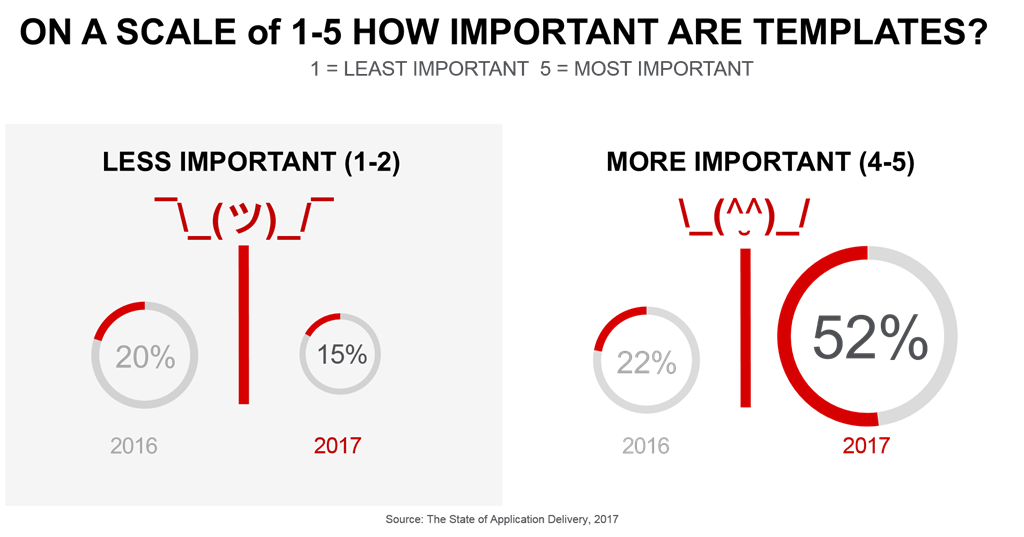Vorlagen erobern die Cloud

Die Cloud – und in diesem Beitrag meine ich damit Infrastructure as a Service (IaaS) – ermöglicht geschäftliche Agilität, indem sie in erster Linie diejenigen, die mit der Bereitstellung von Apps beauftragt sind, von der Komplexität der gesamten darunterliegenden Infrastrukturverkabelung befreit. Da die Cloud sich nicht um die Netzwerkfunktionen kümmern muss, die für alle Apps erforderlich sind, erspart sie denjenigen, die einfach sofort eine App herausbringen möchten, eine Menge Ärger.
Der Punkt ist, dass keine App eine Insel ist und es eine Vielzahl von App-Diensten gibt, die ebenfalls bereitgestellt werden müssen. Bei diesen Diensten handelt es sich um alle Dienste, die in den Datenpfad eingefügt werden – also die Route, die Anfragen und Antworten auf ihrer Reise vom Client zum Server und zurück nehmen. Dazu gehören Lastausgleich, App-Sicherheit, Caching, Verschlüsselung und Beschleunigung, um nur einige zu nennen. In unserem jährlichen Bericht zum Stand der Anwendungsbereitstellung verfolgen wir 26 davon, und ich bin ziemlich sicher, dass wir immer noch nicht alle verfolgen.
Aber ich schweife ab. Der Punkt ist, dass nicht nur Apps Abstraktionsmechanismen benötigen, wenn sie so einfach und schnell sein sollen wie die Cloud selbst. Allerdings bringt jeder dieser App-Dienste seine eigenen Herausforderungen mit sich, insbesondere im Hinblick auf die erforderliche Konfiguration zur Einbindung in die Architektur. Es gibt einen Grund, warum die Bereitstellung einer App in der Produktion einige Zeit in Anspruch nimmt. Einer der Gründe dafür ist die Notwendigkeit, app-spezifische Dienste für die Bereitstellung und Sicherung einzusetzen.
Cloud-Architekturen sind ähnlich und doch unterschiedlich. Und da 29 % der Unternehmen Cloud-Kenntnisse als Herausforderung für ihre Multi-Cloud-Bemühungen angeben, benötigen sie eine Antwort für die Cloud, die die Komplexität der Bereitstellung dieser App-Dienste reduziert. Sie benötigen eine Abstraktion, wie sie die Cloud für das Netzwerk bietet.
Geben Sie Vorlagen ein.
Vorlagen haben in den letzten Jahren an Bedeutung gewonnen, und das ist nicht nur eine Beobachtung. Mehr als die Hälfte (52 %) der Befragten aus allen IT-Funktionen legten in unserer jüngsten Umfrage großen Wert auf Vorlagen. Das ist ein gutes Zeichen für Cloud-Anbieter, sowohl für öffentliche (Amazon, Microsoft, Google) als auch für private (OpenStack). Das liegt daran, dass alle drei Vorlagen bieten, die die Bereitstellung der gesamten Architektur beschleunigen – von Apps bis zu den erforderlichen Diensten, um die von Unternehmen und Benutzern gleichermaßen erwartete Sicherheit, Geschwindigkeit und Verfügbarkeit zu gewährleisten.
Leider – oder vielleicht ist es angesichts des Marktes realistisch – sind diese Vorlagen nicht ohne Weiteres kompatibel. Sie können eine AWS-Vorlage nicht mit Azure verwenden und umgekehrt. Dies spiegelt ähnliche Herausforderungen der Vergangenheit im Zusammenhang mit den Bemühungen zur Standardisierung des Infrastrukturmanagements wider. Die den einzelnen Clouds zugrunde liegenden Modelle sind unterschiedlich und es ist wahrscheinlich schon viel zu spät, um mit einer Normalisierung des Marktes zu rechnen. Aus diesem Grund ist es für eine Cloud-fähige Anwendungsbereitstellungsplattform wichtig, nicht nur App-Dienste zu unterstützen, sondern auch Vorlagen für diese bereitzustellen, die mit Cloud-Vorlagen für diese Cloud-Anbieter kompatibel sind. Die Plattform für AWS, Azure oder OpenStack verfügbar zu machen, ist nur der erste Schritt; die Bereitstellung cloudspezifischer Vorlagen, die die Komplexität reduzieren und das Bereitstellungserlebnis verbessern, ist ein Muss.
Dies verringert nicht nur den Aufwand, der mit der Unterstützung eines Multi-Cloud-Modells verbunden ist, sondern ermöglicht auch einen Infrastruktur-als-Code-Ansatz zur Verwaltung dieser Architekturen, indem Konfigurationsartefakte bereitgestellt werden, die über einen Repository-Ansatz gespeichert, versioniert und verwaltet werden können. Ein vorlagenbasierter Ansatz zum Bereitstellen und Verwalten von App-Diensten bietet Sicherheitsmitarbeitern die Möglichkeit, allgemeine Richtlinien durchzusetzen, indem sie diese in eine gemeinsame Vorlage einbetten. Dadurch werden andere Betriebsteams von der Verantwortung entlastet, Richtlinien zu interpretieren und richtig zu kodifizieren. Zudem verringert sich der Aufwand, der erforderlich ist, um eine App-Bereitstellung reibungsloser durch die Produktionspipeline zu bewegen.
Vorlagen werden in der Cloud bald die Oberhand gewinnen und als Best Practice für die Bereitstellung umfassenderer Architekturen dienen, die Unternehmen benötigen, wenn sie ihren Benutzern (Unternehmen oder Privatkunden) Anwendungen bereitstellen.
Von F5 unterstützte Vorlagen für Amazon AWS, Microsoft Azure und OpenStack finden Sie auf unserem GitHub-Konto https://github.com/f5networks
